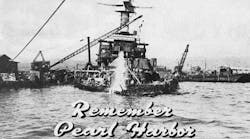I've been working on my next series of blogs about a column we used to run called "Circuit of the Month." I found a few of them, but I want to have them all accounted for before I begin the series.
In the meantime, it's hard to resist looking through some of the old issues for nuggets of interesting and useful information. If found one in our first issue, from February 1948. Many of the issues in the late 1940s and early 1950s had frequent references to patriotism and WWII. The article I'm reproducing here describes some of the salvage efforts to raise the USS California and others after they were sunk or capsized at Pearl Harbor on December 7, 1941. I find it especially interesting how quickly things got done. Here is the article, pretty much as it appeared nearly 70 ears ago:
Remember Pearl Harbor
THE DAMAGE at Pearl Harbor — eight battleships and ten other warships sunk or disabled — called for one of the most urgent salvage jobs in history. The most critical part of the salvage was to clear the entrance channel of the harbor. The securing of cables, the enormous lifting power required and the delicacy of the actual lifting and righting of 30,000-ton hulks called for more large, specially equipped cranes and hoists than the entire Navy possessed. Industry rose to the occasion.
Six of the cranes or hoists used for the job were Manitowoc Model 3000 cranes with a 50-ton capacity at a 12-foot hoisting radius. All six cranes were hydraulic torque converter equipped. The Manitowoc Engineering Works, Manitowoc, Wisc., had three converters installed on completed cranes awaiting shipment. The converters were immediately stripped from the completed cranes and installed in the 50-ton cranes required by the Navy. The first crane was actually shipped within a week. One converter each was shipped on January 3, 6 and 9, which permitted Manitowoc to ship their last unit within six weeks after receipt of the order from the Navy Department.
The salvage job was complicated by the fact that several battleships lay in forty to sixty feet of soft mud. It was necessary to run cables around the hulls and hold the dead weight of the water-filled ships while the mud was sludged away, emergency repairs made, the holds pumped clear and the delicate raising and righting operations completed.
This operation involved torque converter-equipped hoists produced by the Winch and Hoist Division of Six Wheels, Inc., Los Angeles. Six Wheels, Inc. placed an order on December 16, 1941, for twelve hydraulic torque converters supported by a AA priority rating. Seven of the converters were shipped before the end of the month, and the balance of five units went forward the week of January 5th, making it possible for Six Wheels, Inc. to make delivery of their salvaging hoists in record time.
The splendid job that Six Wheels, Inc. did in delivering the twelve salvaging hoists to the Navy had one interesting background incident, which is released now for the first time. One day in November, 1940, a naval salvage engineer walked into the Six Wheels Inc., office. He laid down specifications for a hoist that was to be powered by an internal combustion engine, but which had to exhibit the power ability and smoothness characteristic of a steam generated unit and with all load shocks (characteristic in cable, gears and chain) eliminated. The engine had to act as a steam throttle throughout the entire torque-speed range. The overall dimensions had to be held to the minimum width, height and length. The total weight was restricted to 10,000 pounds for each hoist. Each unit, consisting of not more than four parts, which could not exceed 3300 pounds each. An essential specification was that the complete hoist be assembled and disassembled into four parts in one-and-a-half hours.
The design, taking the sacrifice of weight and other normal safety factors into consideration, required the very finest materials in construction to ensure 100 percent performance. The officer's closing statement summed up the urgency. “We do not have a second chance to come back — It's now or never."
Six Wheels, Inc., accepted the challenge and was given the go-ahead on three units. Experience gained with these units made the delivery of the first twelve hoists at Pearl Harbor possible in record time.
Although the story is almost forgotten, the torque converter was one of the first jobs that went to war.


